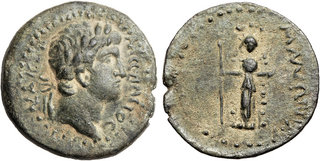This record is provided by CoinArchives, a database of numismatic auction catalogs.
Important copyright information:
The data below is presented by permission of the copyright holder(s). Reproduction is allowed only by authorization from Heritage World Coin Auctions.
Important copyright information:
The data below is presented by permission of the copyright holder(s). Reproduction is allowed only by authorization from Heritage World Coin Auctions.
| Heritage World Coin Auctions > CICF Signature Sale 3024 | Auction date: 18 April 2013 |
| Lot number: 24793 | |
| Lot description: Ancients CILICIA. Mallus. Otho (AD 69). Æ24mm (7.40 gm, 12h). KAICAP M CABACTOC (some letters ligate and / or blundered), laureate head of Otho right / MAΛΛΩN, cult image of Atargatis facing, arms extended, holding spear in right hand and flower in left, barley stalk rising from each shoulder. Muona, Jyrki, in Finnish Numismatic Society Journal no. 6 (Helsinki 2008), RPC --. SNG Von Aulock --. SNG France --. SNG Levante --. Apparently one of two known examples! Detailed strike, bold portrait. Beautiful light green-earthen patina. Choice Extremely Fine / Very Fine. Although the obverse legend on this remarkable piece is enigmatic, an article by noted Finnish numismatist Jyrki Muona in the 2008 FNS Journal identifies this nearly unique issue (aside from the example cited in the article) as a coin of M. Salvius Otho, emperor for 90 days from January to April of AD 69. According to Muona, "the portrait is clearly Julio-Claudian and the ethnic fixes the mint beyond question. The coin is undated and the obverse legend is enigmatic. RPC I and its supplements (Brunett et al., 1992, 1998, 2006) list altogether 12 Julio-Claudian coin types from Mallus. All of these coins are rare. They are classified as having been minted for Augustus (3 types, 5 coins), Caligula (3 types, 8 coins), Claudius (1 type, 4 coins) and Nero (4 types, 9 coins). Only the Claudius and Nero coins name the emperor and only two types of coins are dated. In addition RPC I lists one coin (no. 4024) as a possible Galba on the basis of the date (EAP in Mallus corresponds to 67/68 CE) and the portrait, which clearly cannot depict Nero. On the basis of the previously known coins from Mallus, the absence of the emperor's name and the date are common features for the mint at the time. Even if it is assumed that garbled letters exist between the KAICAP and the M on the obverse, no obvious explanation for the letter M exists. The obverse portrait offers an answer, however. It is undoubtedly that of Otho, heavily influenced by the Antioch mint style, but not cut by Antioch engravers (see McAlee, 2007 for portraits of Galba and Otho from Antioch). The bent nose might be seen as a feature pointing to Galba, but the rounded, full cheek and complete absence of furrows and other signs of old age definitely point to a younger man. Provincial Othos were known from Antioch and Alexandria. They are surprisingly common and diverse considering the short reign of the emperor. The parts of Cilicia where Mallus was located, were under the Roman province Syria at the time. During the struggle for power between Otho and Vitellius in 69 CE, the eastern provinces and their army under the rule of the future emperor Vespasianus, swore allegiance to Otho. Thus it is natural that Otho's provincial coins all come from mints in the region. Mallus fits this scenario well." Estimate: 3200-4000 USD Estimate: 3200 USD |  |


